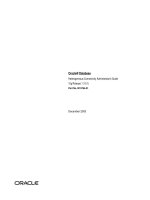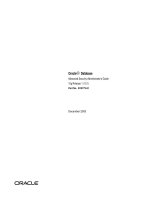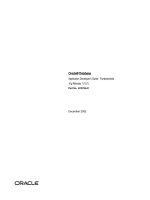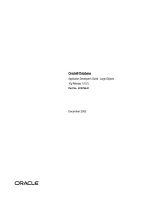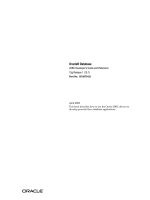Tài liệu Oracle Database Advanced Security Administrator''''s Guide doc
Bạn đang xem bản rút gọn của tài liệu. Xem và tải ngay bản đầy đủ của tài liệu tại đây (3.38 MB, 518 trang )
Oracle
Database
Advanced Security Administrator's Guide
10g Release 1 (10.1)
Part No. B10772-01
December 2003
Oracle Database Advanced Security Administrator's Guide, 10g Release 1 (10.1)
Part No. B10772-01
Copyright © 1996, 2003 Oracle Corporation. All rights reserved.
Primary Author: Laurel P. Hale
Contributors: Rajbir Chahal, Min-Hank Ho, Michael Hwa, Sudha Iyer, Adam Lindsey Jacobs, Supriya
Kalyanasundaram, Lakshmi Kethana, Andrew Koyfman, Van Le, Nina Lewis, Stella Li, Janaki
Narasinghanallur, Vikram Pesati, Andy Philips, Richard Smith, Deborah Steiner, Philip Thornton,
Ramana Turlapati
Graphic Designer: Valarie Moore
The Programs (which include both the software and documentation) contain proprietary information of
Oracle Corporation; they are provided under a license agreement containing restrictions on use and
disclosure and are also protected by copyright, patent and other intellectual and industrial property
laws. Reverse engineering, disassembly or decompilation of the Programs, except to the extent required
to obtain interoperability with other independently created software or as specified by law, is prohibited.
The information contained in this document is subject to change without notice. If you find any problems
in the documentation, please report them to us in writing. Oracle Corporation does not warrant that this
document is error-free. Except as may be expressly permitted in your license agreement for these
Programs, no part of these Programs may be reproduced or transmitted in any form or by any means,
electronic or mechanical, for any purpose, without the express written permission of Oracle Corporation.
If the Programs are delivered to the U.S. Government or anyone licensing or using the programs on
behalf of the U.S. Government, the following notice is applicable:
Restricted Rights Notice Programs delivered subject to the DOD FAR Supplement are "commercial
computer software" and use, duplication, and disclosure of the Programs, including documentation,
shall be subject to the licensing restrictions set forth in the applicable Oracle license agreement.
Otherwise, Programs delivered subject to the Federal Acquisition Regulations are "restricted computer
software" and use, duplication, and disclosure of the Programs shall be subject to the restrictions in FAR
52.227-19, Commercial Computer Software - Restricted Rights (June, 1987). Oracle Corporation, 500
Oracle Parkway, Redwood City, CA 94065.
The Programs are not intended for use in any nuclear, aviation, mass transit, medical, or other inherently
dangerous applications. It shall be the licensee's responsibility to take all appropriate fail-safe, backup,
redundancy, and other measures to ensure the safe use of such applications if the Programs are used for
such purposes, and Oracle Corporation disclaims liability for any damages caused by such use of the
Programs.
Oracle is a registered trademark, and Oracle Store, Oracle8i, Oracle9i, PL/SQL, SQL*Net, SQL*Plus, and
Secure Network Services are trademarks or registered trademarks of Oracle Corporation. Other names
may be trademarks of their respective owners.
Portions of Oracle Advanced Security have been licensed by Oracle
Corporation from RSA Data Security.
This program contains third-party code from Massachusetts Institute of Technology (M.I.T.), OpenVision
Technologies, Inc., and the Regents of the University of California. Under the terms of the Kerberos
license, Oracle is required to license the Kerberos software to you under the following terms. Note that
the terms contained in the Oracle program license that accompanied this product do not apply to the
Kerberos software, and your rights to use the software are solely as set forth below. Oracle is not
responsible for the performance of the Kerberos software, does not provide technical support for the
software, and shall not be liable for any damages arising out of any use of the Kerberos software.
Copyright © 1985-2002 by the Massachusetts Institute of Technology.
All rights reserved.
Export of this software from the United States of America may require a specific license from the United
States Government. It is the responsibility of any person or organization contemplating export to obtain
such a license before exporting.
WITHIN THAT CONSTRAINT, permission to use, copy, modify, and distribute this software and its
documentation for any purpose and without fee is hereby granted, provided that the above copyright
notice appear in all copies and that both that copyright notice and this permission notice appear in
supporting documentation, and that the name of M.I.T. not be used in advertising or publicity pertaining
to distribution of the software without specific, written prior permission. Furthermore, if you modify this
software you must label your software as modified software and not distribute it in such a fashion that it
might be confused with the original M.I.T. software. M.I.T. makes no representations about the suitability
of this software for any purpose. It is provided "as is" without express or implied warranty.
THIS SOFTWARE IS PROVIDED "AS IS" AND WITHOUT ANY EXPRESS OR IMPLIED WARRANTIES,
INCLUDING, WITHOUT LIMITATION, THE IMPLIED WARRANTIES OF MERCHANTIBILITY AND
FITNESS FOR A PARTICULAR PURPOSE.
Individual source code files are copyright M.I.T., Cygnus Support, OpenVision, Oracle, Sun Soft,
FundsXpress, and others.
Project Athena, Athena, Athena MUSE, Discuss, Hesiod, Kerberos, Moira, and Zephyr are trademarks of
the Massachusetts Institute of Technology (M.I.T.). No commercial use of these trademarks may be made
without prior written permission of M.I.T.
"Commercial use" means use of a name in a product or other for-profit manner. It does NOT prevent a
commercial firm from referring to the M.I.T. trademarks in order to convey information (although in
doing so, recognition of their trademark status should be given).
The following copyright and permission notice applies to the OpenVision Kerberos Administration
system located in kadmin/create, kadmin/dbutil, kadmin/passwd, kadmin/server, lib/kadm5, and
portions of lib/rpc:
Copyright, OpenVision Technologies, Inc., 1996, All Rights Reserved
WARNING: Retrieving the OpenVision Kerberos Administration system source code, as described
below, indicates your acceptance of the following terms. If you do not agree to the following terms, do
not retrieve the OpenVision Kerberos administration system.
You may freely use and distribute the Source Code and Object Code compiled from it, with or without
modification, but this Source Code is provided to you "AS IS" EXCLUSIVE OF ANY WARRANTY,
INCLUDING, WITHOUT LIMITATION, ANY WARRANTIES OF MERCHANTABILITY OR FITNESS
FOR A PARTICULAR PURPOSE, OR ANY OTHER WARRANTY, WHETHER EXPRESS OR IMPLIED.
IN NO EVENT WILL OPENVISION HAVE ANY LIABILITY FOR ANY LOST PROFITS, LOSS OF
DATA, OR COSTS OF PROCUREMENT OF SUBSTITUTE GOODS OR SERVICES, OR FOR ANY
SPECIAL, INDIRECT, OR CONSEQUENTIAL DAMAGES ARISING OUT OF THIS AGREEMENT,
INCLUDING, WITHOUT LIMITATION, THOSE RESULTING FROM THE USE OF THE SOURCE
CODE, OR THE FAILURE OF THE SOURCE CODE TO PERFORM, OR FOR ANY OTHER REASON.
OpenVision retains all copyrights in the donated Source Code. OpenVision also retains copyright to
derivative works of the Source Code, whether created by OpenVision or by a third party. The OpenVision
copyright notice must be preserved if derivative works are made based on the donated Source Code.
OpenVision Technologies, Inc., has donated this Kerberos Administration system to M.I.T. for inclusion
in the standard Kerberos 5 distribution. This donation underscores our commitment to continuing
Kerberos technology development and our gratitude for the valuable work which has been performed by
M.I.T. and the Kerberos community.
Portions contributed by Matt Crawford <> were work performed at Fermi National
Accelerator Laboratory, which is operated by Universities Research Association, Inc., under contract
DE-AC02-76CHO3000 with the U. S. Department of Energy.
v
Contents
List of Figures
List of Tables
Send Us Your Comments xxiii
Preface xxv
What's New in Oracle Advanced Security? xxxvii
Part I Getting Started with Oracle Advanced Security
1 Introduction to Oracle Advanced Security
Security Challenges in an Enterprise Environment 1-1
Security in Enterprise Grid Computing Environments 1-2
Security in an Intranet or Internet Environment 1-2
Common Security Threats 1-3
Solving Security Challenges with Oracle Advanced Security 1-4
Data Encryption 1-5
Strong Authentication 1-8
Enterprise User Management 1-13
Oracle Advanced Security Architecture 1-15
Secure Data Transfer Across Network Protocol Boundaries 1-16
System Requirements 1-16
Oracle Advanced Security Restrictions 1-17
vi
2 Configuration and Administration Tools Overview
Network Encryption and Strong Authentication Configuration Tools 2-2
Oracle Net Manager 2-2
Oracle Advanced Security Kerberos Adapter Command-Line Utilities 2-5
Public Key Infrastructure Credentials Management Tools 2-6
Oracle Wallet Manager 2-6
orapki Utility 2-12
Enterprise User Security Configuration and Management Tools 2-13
Database Configuration Assistant 2-13
Enterprise Security Manager and Enterprise Security Manager Console 2-14
Oracle Net Configuration Assistant 2-32
User Migration Utility 2-33
Duties of a Security Administrator/DBA 2-34
Duties of an Enterprise User Security Administrator/DBA 2-35
Part II Network Data Encryption and Integrity
3 Configuring Network Data Encryption and Integrity for Oracle Servers and
Clients
Oracle Advanced Security Encryption 3-1
About Encryption 3-2
Advanced Encryption Standard 3-2
DES Algorithm Support 3-2
Triple-DES Support 3-2
RSA RC4 Algorithm for High Speed Encryption 3-3
Oracle Advanced Security Data Integrity 3-3
Data Integrity Algorithms Supported 3-4
Diffie-Hellman Based Key Management 3-4
Authentication Key Fold-in 3-5
How To Configure Data Encryption and Integrity 3-5
About Activating Encryption and Integrity 3-6
About Negotiating Encryption and Integrity 3-6
Setting the Encryption Seed (Optional) 3-8
Configuring Encryption and Integrity Parameters Using Oracle Net Manager 3-9
vii
4 Configuring Network Data Encryption and Integrity for Thin JDBC Clients
About the Java Implementation 4-1
Java Database Connectivity Support 4-1
Securing Thin JDBC 4-2
Implementation Overview 4-3
Obfuscation 4-3
Configuration Parameters 4-4
Client Encryption Level: ORACLE.NET.ENCRYPTION_CLIENT 4-4
Client Encryption Selected List: ORACLE.NET.ENCRYPTION_TYPES_CLIENT 4-5
Client Integrity Level: ORACLE.NET.CRYPTO_CHECKSUM_CLIENT 4-5
Client Integrity Selected List: ORACLE.NET.CRYPTO_CHEKSUM_TYPES_CLIENT 4-6
Part III Oracle Advanced Security Strong Authentication
5 Configuring RADIUS Authentication
RADIUS Overview 5-1
RADIUS Authentication Modes 5-3
Synchronous Authentication Mode 5-3
Challenge-Response (Asynchronous) Authentication Mode 5-5
Enabling RADIUS Authentication, Authorization, and Accounting 5-8
Task 1: Install RADIUS on the Oracle Database Server and on the Oracle Client 5-9
Task 2: Configure RADIUS Authentication 5-9
Task 3: Create a User and Grant Access 5-17
Task 4: Configure External RADIUS Authorization (optional) 5-17
Task 5: Configure RADIUS Accounting 5-19
Task 6: Add the RADIUS Client Name to the RADIUS Server Database 5-20
Task 7: Configure the Authentication Server for Use with RADIUS 5-20
Task 8: Configure the RADIUS Server for Use with the Authentication Server 5-20
Task 9: Configure Mapping Roles 5-21
Using RADIUS to Log In to a Database 5-22
RSA ACE/Server Configuration Checklist 5-22
6 Configuring Kerberos Authentication
Enabling Kerberos Authentication 6-2
viii
Task 1: Install Kerberos 6-2
Task 2: Configure a Service Principal for an Oracle Database Server 6-2
Task 3: Extract a Service Table from Kerberos 6-3
Task 4: Install an Oracle Database Server and an Oracle Client 6-4
Task 5: Install Oracle Net Services and Oracle Advanced Security 6-5
Task 6: Configure Oracle Net Services and Oracle Database 6-5
Task 7: Configure Kerberos Authentication 6-5
Task 8: Create a Kerberos User 6-10
Task 9: Create an Externally Authenticated Oracle User 6-10
Task 10: Get an Initial Ticket for the Kerberos/Oracle User 6-11
Utilities for the Kerberos Authentication Adapter 6-11
Obtaining the Initial Ticket with the okinit Utility 6-11
Displaying Credentials with the oklist Utility 6-12
Removing Credentials from the Cache File with the okdstry Utility 6-13
Connecting to an Oracle Database Server Authenticated by Kerberos 6-13
Configuring Interoperability with a Windows 2000 Domain Controller KDC 6-13
Task 1: Configuring an Oracle Kerberos Client to Interoperate with a Windows 2000
Domain Controller KDC 6-14
Task 2: Configuring a Windows 2000 Domain Controller KDC to Interoperate with an
Oracle Client 6-15
Task 3: Configuring an Oracle Database to Interoperate with a Windows 2000 Domain
Controller KDC 6-17
Task 4: Getting an Initial Ticket for the Kerberos/Oracle User 6-17
Troubleshooting 6-18
7 Configuring Secure Sockets Layer Authentication
SSL and TLS in an Oracle Environment 7-2
Difference between SSL and TLS 7-2
About Using SSL 7-3
How SSL Works in an Oracle Environment: The SSL Handshake 7-4
Public Key Infrastructure in an Oracle Environment 7-5
About Public Key Cryptography 7-5
Public Key Infrastructure Components in an Oracle Environment 7-6
SSL Combined with Other Authentication Methods 7-10
Architecture: Oracle Advanced Security and SSL 7-10
ix
How SSL Works with Other Authentication Methods 7-10
SSL and Firewalls 7-12
SSL Usage Issues 7-14
Enabling SSL 7-15
Task 1: Install Oracle Advanced Security and Related Products 7-15
Task 2: Configure SSL on the Server 7-15
Task 3: Configure SSL on the Client 7-23
Task 4: Log on to the Database 7-31
Troubleshooting SSL 7-31
Certificate Validation with Certificate Revocation Lists 7-35
What CRLs Should You Use? 7-35
How CRL Checking Works 7-36
Configuring Certificate Validation with Certificate Revocation Lists 7-37
Certificate Revocation List Management 7-40
Troubleshooting Certificate Validation 7-45
Configuring Your System to Use Hardware Security Modules 7-48
General Guidelines for Using Hardware Security Modules with Oracle Advanced Security
7-48
Configuring Your System to Use nCipher Hardware Security Modules 7-49
Troubleshooting Using Hardware Security Modules 7-50
8 Using Oracle Wallet Manager
Oracle Wallet Manager Overview 8-2
Wallet Password Management 8-2
Strong Wallet Encryption 8-3
Microsoft Windows Registry Wallet Storage 8-3
Backward Compatibility 8-3
Public-Key Cryptography Standards (PKCS) Support 8-3
Multiple Certificate Support 8-4
LDAP Directory Support 8-7
Starting Oracle Wallet Manager 8-7
How To Create a Complete Wallet: Process Overview 8-8
Managing Wallets 8-9
Required Guidelines for Creating Wallet Passwords 8-9
Creating a New Wallet 8-10
x
Opening an Existing Wallet 8-13
Closing a Wallet 8-13
Importing Third-Party Wallets 8-13
Exporting Oracle Wallets to Third-Party Environments 8-14
Exporting Oracle Wallets to Tools that Do Not Support PKCS #12 8-14
Uploading a Wallet to an LDAP Directory 8-15
Downloading a Wallet from an LDAP Directory 8-16
Saving Changes 8-17
Saving the Open Wallet to a New Location 8-17
Saving in System Default 8-17
Deleting the Wallet 8-18
Changing the Password 8-18
Using Auto Login 8-19
Managing Certificates 8-20
Managing User Certificates 8-20
Managing Trusted Certificates 8-25
9 Configuring Multiple Authentication Methods and Disabling Oracle
Advanced Security
Connecting with User Name and Password 9-1
Disabling Oracle Advanced Security Authentication 9-2
Configuring Multiple Authentication Methods 9-4
Configuring Oracle Database for External Authentication 9-5
Setting the SQLNET.AUTHENTICATION_SERVICES Parameter in sqlnet.ora 9-5
Verifying that REMOTE_OS_AUTHENT Is Not Set to TRUE 9-5
Setting OS_AUTHENT_PREFIX to a Null Value 9-6
10 Configuring Oracle DCE Integration
Introduction to Oracle DCE Integration 10-2
System Requirements 10-2
Backward Compatibility 10-2
Components of Oracle DCE Integration 10-2
Flexible DCE Deployment 10-4
Release Limitations 10-4
Configuring DCE for Oracle DCE Integration 10-5
xi
Task 1: Create New Principals and Accounts 10-5
Task 2: Install the Key of the Server into a Keytab File 10-6
Task 3: Configure DCE CDS for Use by Oracle DCE Integration 10-6
Configuring Oracle Database and Oracle Net Services for Oracle DCE Integration 10-8
DCE Address Parameters 10-8
Task 1: Configure the Server 10-9
Task 2: Create and Name Externally Authenticated Accounts 10-10
Task 3: Set up DCE Integration External Roles 10-12
Task 4: Configure DCE for SYSDBA and SYSOPER Connections to Oracle Databases 10-15
Task 5: Configure the Client 10-16
Task 6: Configure Clients to Use DCE CDS Naming 10-19
Connecting to an Oracle Database Server in the DCE Environment 10-23
Starting the Listener 10-23
Connecting to an Oracle Database by Using DCE Authentication for Single Sign-On 10-24
Connecting to an Oracle Database by Using Password Authentication 10-25
Connecting Clients Outside DCE to Oracle Servers in DCE 10-25
Sample Parameter Files 10-25
Using tnsnames.ora for Name Lookup When CDS Is Inaccessible 10-28
Part IV Enterprise User Security
11 Getting Started with Enterprise User Security
Introduction to Enterprise User Security 11-2
The Challenges of User Management 11-2
Enterprise User Security: The Big Picture 11-3
About Enterprise User Security Directory Entries 11-11
About Using Shared Schemas for Enterprise User Security 11-19
Overview of Shared Schemas Used in Enterprise User Security 11-19
How Shared Schemas Are Configured for Enterprise Users 11-20
How Enterprise Users Are Mapped to Schemas 11-20
About Using Current User Database Links for Enterprise User Security 11-23
Enterprise User Security Deployment Considerations 11-25
Security Aspects of Centralizing Security Credentials 11-25
Security of Password-Authenticated Enterprise User Database Login Information 11-26
Considerations for Defining Database Membership in Enterprise Domains 11-27
xii
Considerations for Choosing Authentication Types between Clients, Databases, and
Directories for Enterprise User Security 11-28
12 Enterprise User Security Configuration Tasks and Troubleshooting
Enterprise User Security Configuration Overview 12-1
Enterprise User Security Configuration Roadmap 12-4
Preparing the Directory for Enterprise User Security 12-5
Configuring Enterprise User Security Objects in the Database and the Directory 12-11
Configuring Enterprise User Security for Password Authentication 12-16
Configuring Enterprise User Security for Kerberos Authentication 12-18
Configuring Enterprise User Security for SSL Authentication 12-21
Viewing the Database DN in the Wallet and in the Directory 12-24
Enabling Current User Database Links 12-25
Troubleshooting Enterprise User Security 12-26
ORA-# Errors for Password-Authenticated Enterprise Users 12-26
ORA-# Errors for Kerberos-Authenticated Enterprise Users 12-29
ORA-# Errors for SSL-Authenticated Enterprise Users 12-32
NO-GLOBAL-ROLES Checklist 12-33
USER-SCHEMA ERROR Checklist 12-34
DOMAIN-READ-ERROR Checklist 12-35
13 Administering Enterprise User Security
Enterprise User Security Administration Tools Overview 13-2
Administering Identity Management Realms 13-3
Identity Management Realm Versions 13-4
Setting Properties of an Identity Management Realm 13-5
Setting Login Name, Kerberos Principal Name, User Search Base, and Group Search Base
Identity Management Realm Attributes 13-5
Setting the Default Database-to-Directory Authentication Type for an Identity Management
Realm 13-6
Managing Identity Management Realm Administrators 13-7
Administering Enterprise Users 13-8
Creating New Enterprise Users 13-9
Setting Enterprise User Passwords 13-10
Defining an Initial Enterprise Role Assignment 13-11
xiii
Browsing Users in the Directory 13-12
Administering Enterprise Domains 13-15
Creating a New Enterprise Domain 13-16
Defining Database Membership of an Enterprise Domain 13-17
Managing Database Security Options for an Enterprise Domain 13-19
Managing Enterprise Domain Administrators 13-20
Managing Enterprise Domain Database Schema Mappings 13-20
Managing Password Accessible Domains 13-23
Managing Database Administrators 13-25
Administering Enterprise Roles 13-27
Creating a New Enterprise Role 13-27
Assigning Database Global Role Membership to an Enterprise Role 13-28
Granting Enterprise Roles to Users 13-31
Part V Appendixes
A Data Encryption and Integrity Parameters
Sample sqlnet.ora File A-1
Data Encryption and Integrity Parameters A-3
Encryption and Integrity Parameters A-4
Seeding the Random Key Generator (Optional) A-8
B Authentication Parameters
Parameters for Clients and Servers using Kerberos Authentication B-1
Parameters for Clients and Servers using RADIUS Authentication B-2
sqlnet.ora File Parameters B-2
Minimum RADIUS Parameters B-6
Initialization File Parameters B-7
Parameters for Clients and Servers using SSL B-7
SSL Authentication Parameters B-7
Cipher Suite Parameters B-8
SSL Version Parameters B-9
SSL Client Authentication Parameters B-10
Wallet Location B-12
xiv
C Integrating Authentication Devices Using RADIUS
About the RADIUS Challenge-Response User Interface C-1
Customizing the RADIUS Challenge-Response User Interface C-2
D Oracle Advanced Security FIPS 140-1 Settings
Configuration Parameters D-1
Server Encryption Level Setting D-2
Client Encryption Level Setting D-2
Server Encryption Selection List D-2
Client Encryption Selection List D-3
Cryptographic Seed Value D-3
FIPS Parameter D-3
Post Installation Checks D-4
Status Information D-4
Physical Security D-5
E orapki Utility
orapki Utility Overview E-2
orapki Utility Syntax E-2
Creating Signed Certificates for Testing Purposes E-3
Managing Oracle Wallets with orapki Utility E-4
Creating and Viewing Oracle Wallets with orapki E-4
Adding Certificates and Certificate Requests to Oracle Wallets with orapki E-5
Exporting Certificates and Certificate Requests from Oracle Wallets with orapki E-6
Managing Certificate Revocation Lists (CRLs) with orapki Utility E-6
orapki Utility Commands Summary E-7
orapki cert create E-7
orapki cert display E-8
orapki crl delete E-8
orapki crl display E-9
orapki crl hash E-10
orapki crl list E-10
orapki crl upload E-11
orapki wallet add E-12
xv
orapki wallet create E-13
orapki wallet display E-13
orapki wallet export E-13
F Entrust-Enabled SSL Authentication
Benefits of Entrust-Enabled Oracle Advanced Security F-2
Enhanced X.509-Based Authentication and Single Sign-On F-2
Integration with Entrust Authority Key Management F-2
Integration with Entrust Authority Certificate Revocation F-2
Required System Components for Entrust-Enabled Oracle Advanced Security F-3
Entrust Authority for Oracle F-3
Entrust Authority Server Login Feature F-4
Entrust Authority IPSec Negotiator Toolkit F-5
Entrust Authentication Process F-5
Enabling Entrust Authentication F-6
Creating Entrust Profiles F-6
Installing Oracle Advanced Security and Related Products for Entrust-Enabled SSL F-8
Configuring SSL on the Client and Server for Entrust-Enabled SSL F-8
Configuring Entrust on the Client F-8
Configuring Entrust on the Server F-9
Creating Entrust-Enabled Database Users F-12
Logging Into the Database Using Entrust-Enabled SSL F-12
Issues and Restrictions that Apply to Entrust-Enabled SSL F-12
Troubleshooting Entrust In Oracle Advanced Security F-13
Error Messages Returned When Running Entrust on Any Platform F-13
Error Messages Returned When Running Entrust on Windows Platforms F-15
General Checklist for Running Entrust on Any Platform F-17
G Using the User Migration Utility
Benefits of Migrating Local or External Users to Enterprise Users G-1
Introduction to the User Migration Utility G-2
Bulk User Migration Process Overview G-3
About the ORCL_GLOBAL_USR_MIGRATION_DATA Table G-4
Migration Effects on Users' Old Database Schemas G-6
Migration Process G-7
xvi
Prerequisites for Performing Migration G-8
Required Database Privileges G-8
Required Directory Privileges G-9
Required Setup to Run the User Migration Utility G-9
User Migration Utility Command Line Syntax G-10
Accessing Help for the User Migration Utility G-11
User Migration Utility Parameters G-12
User Migration Utility Usage Examples G-20
Migrating Users While Retaining Their Own Schemas G-20
Migrating Users and Mapping to a Shared Schema G-21
Migrating Users Using the PARFILE, USERSFILE, and LOGFILE Parameters G-25
Troubleshooting Using the User Migration Utility G-26
Common User Migration Utility Error Messages G-26
Common User Migration Utility Log Messages G-32
Summary of User Migration Utility Error and Log Messages G-34
Glossary
Index
xvii
xviii
List of Figures
1–1 Encryption 1-5
1–2 Strong Authentication with Oracle Authentication Adapters 1-8
1–3 How a Network Authentication Service Authenticates a User 1-9
1–4 Centralized User Management with Enterprise User Security 1-13
1–5 Oracle Advanced Security in an Oracle Networking Environment 1-15
1–6 Oracle Net with Authentication Adapters 1-16
2–1 Oracle Advanced Security Profile in Oracle Net Manager 2-4
2–2 Oracle Wallet Manager User Interface 2-7
2–3 Certificate Request Information Displayed in Oracle Wallet Manager Right Pane 2-9
2–4 Directory Server Login Window 2-17
2–5 Enterprise Security Manager User Interface 2-18
2–6 Enterprise Security Manager Databases Tabbed Window 2-20
2–7 Enterprise Security Manager Console Login Page 2-23
2–8 ESM Console URL Window 2-24
2–9 Enterprise Security Manager Console User Interface 2-25
2–10 Enterprise Security Manager Console Users Subtab 2-26
2–11 Enterprise Security Manager Console Group Subtab 2-28
2–12 Enterprise Security Manager Console Edit Group Page 2-29
2–13 Enterprise Security Manager Console Realm Configuration Tabbed Window 2-30
2–14 Opening Page of Oracle Net Configuration Assistant 2-33
3–1 Oracle Advanced Security Encryption Window 3-10
3–2 Oracle Advanced Security Integrity Window 3-12
5–1 RADIUS in an Oracle Environment 5-2
5–2 Synchronous Authentication Sequence 5-4
5–3 Asynchronous Authentication Sequence 5-6
5–4 Oracle Advanced Security Authentication Window 5-10
5–5 Oracle Advanced Security Other Params Window 5-12
6–1 Oracle Advanced Security Authentication Window (Kerberos) 6-6
6–2 Oracle Advanced Security Other Params Window (Kerberos) 6-7
7–1 SSL in Relation to Other Authentication Methods 7-11
7–2 SSL Cipher Suites Window 7-19
7–3 Oracle Advanced Security SSL Window (Server) 7-20
7–4 Oracle Advanced Security SSL Window (Server) 7-22
7–5 Oracle Advanced Security SSL Window (Client) 7-26
7–6 Oracle Advanced Security SSL Window (Client) 7-29
7–7 Oracle Advanced Security SSL Window with Certificate Revocation Checking Selected
7-38
9–1 Oracle Advanced Security Authentication Window 9-3
11–1 Enterprise User Security and the Oracle Security Architecture 11-4
11–2 Example of Enterprise Roles 11-13
xix
11–3 Related Entries in a Realm Oracle Context 11-16
12–1 Enterprise User Security Configuration Flow Chart 12-3
13–1 Enterprise Security Manager Console Home Page 13-9
13–2 Enterprise Security Manager Console Edit User Window: Basic Information 13-10
13–3 Enterprise Security Manager: Add Enterprise Roles Window 13-12
13–4 Enterprise Security Manager: Main Window (All Users Tab) 13-13
13–5 Enterprise Security Manager: Create Enterprise Domain Window 13-16
13–6 Enterprise Security Manager: Databases Tab (Database Membership) 13-17
13–7 Enterprise Security Manager: Add Databases Window 13-18
13–8 Enterprise Security Manager: Database Schema Mappings Tab 13-21
13–9 Enterprise Security Manager: Add Database Schema Mappings Window 13-22
13–10 Enterprise Security Manager: Add Accessible Enterprise Domains Dialog Box 13-24
13–11 Enterprise Security Manager: Create Enterprise Role Window 13-27
13–12 Enterprise Security Manager: Database Global Roles Tab 13-29
13–13 Enterprise Security Manager: Database Authentication Required Window 13-30
13–14 Enterprise Security Manager: Add Enterprise Users Window 13-31
F–1 Entrust Authentication Process F-6
xx
xxi
List of Tables
1–1 Authentication Methods and System Requirements 1-17
2–1 Oracle Wallet Manager Navigator Pane Objects 2-8
2–2 Oracle Wallet Manager Toolbar Buttons 2-10
2–3 Oracle Wallet Manager Wallet Menu Options 2-10
2–4 Oracle Wallet Manager Operations Menu Options 2-11
2–5 Oracle Wallet Manager Help Menu Options 2-12
2–6 Enterprise User Security Tools Summary 2-13
2–7 Enterprise Security Manager Authentication Methods 2-17
2–8 Enterprise Security Manager Navigator Pane Folders 2-19
2–9 Enterprise Security Manager File Menu Options 2-21
2–10 Enterprise Security Manager Operations Menu Options 2-21
2–11 Enterprise Security Manager Help Menu Options 2-21
2–12 Enterprise Security Manager Console User Subtab Buttons 2-27
2–13 Realm Configuration Tabbed Window Fields 2-30
2–14 Common Security Administrator/DBA Configuration and Administrative Tasks. 2-34
2–15 Common Enterprise User Security Administrator Configuration and Administrative
Tasks 2-36
3–1 Encryption and Data Integrity Negotiations 3-8
3–2 Valid Encryption Algorithms 3-11
3–3 Valid Integrity Algorithms 3-13
4–1 ORACLE.NET.ENCRYPTION_CLIENT Parameter Attributes 4-4
4–2 ORACLE.NET.ENCRYPTION_TYPES_CLIENT Parameter Attributes 4-5
4–3 ORACLE.NET.CRYPTO_CHECKSUM_CLIENT Parameter Attributes 4-5
4–4 ORACLE.NET.CRYPTO_CHEKSUM_TYPES_CLIENT Parameter Attributes 4-6
5–1 RADIUS Authentication Components 5-3
5–2 RADIUS Configuration Parameters 5-21
6–1 Options for the okinit Utility 6-11
6–2 Options for the oklist Utility 6-12
7–1 Oracle Advanced Security Cipher Suites 7-18
8–1 KeyUsage Values 8-5
8–2 Oracle Wallet Manager Import of User Certificates to an Oracle Wallet 8-5
8–3 Oracle Wallet Manager Import of Trusted Certificates to an Oracle Wallet 8-6
8–4 PKI Wallet Encoding Standards 8-15
8–5 Certificate Request: Fields and Descriptions 8-21
8–6 Available Key Sizes 8-22
10–1 DCE Address Parameters and Definitions 10-8
10–2 Setting Up External Role Syntax Components 10-13
11–1 Enterprise User Security Authentication: Selection Criteria 11-10
11–2 Administrative Groups in a Realm Oracle Context 11-18
xxii
11–3 Enterprise User Security: Supported Authentication Types for Connections between
Clients, Databases, and Directories 11-28
13–1 Identity Management Realm Properties 13-5
13–2 Enterprise User Security Identity Management Realm Administrators 13-7
13–3 Directory Search Criteria 13-14
13–4 Enterprise Security Manager Database Security Options 13-19
A–1 Algorithm Type Selection A-3
A–2 SQLNET.ENCRYPTION_SERVER Parameter Attributes A-4
A–3 SQLNET.ENCRYPTION_CLIENT Parameter Attributes A-5
A–4 SQLNET.CRYPTO_CHECKSUM_SERVER Parameter Attributes A-5
A–5 SQLNET.CRYPTO_CHECKSUM_CLIENT Parameter Attributes A-5
A–6 SQLNET.ENCRYPTION_TYPES_SERVER Parameter Attributes A-6
A–7 SQLNET.ENCRYPTION_TYPES_CLIENT Parameter Attributes A-7
A–8 SQLNET.CRYPTO_CHECKSUM_TYPES_SERVER Parameter Attributes A-8
A–9 SQLNET.CRYPTO_CHECKSUM_TYPES_CLIENT Parameter Attributes A-8
B–1 Kerberos Authentication Parameters B-1
B–2 SQLNET.AUTHENTICATION_SERVICES Parameter Attributes B-2
B–3 SQLNET.RADIUS_AUTHENTICATION Parameter Attributes B-2
B–4 SQLNET.RADIUS_AUTHENTICATION_PORT Parameter Attributes B-3
B–5 SQLNET.RADIUS_AUTHENTICATION_TIMEOUT Parameter Attributes B-3
B–6 SQLNET.RADIUS_AUTHENTICATION_RETRIES Parameter Attributes B-3
B–7 SQLNET.RADIUS_SEND_ACCOUNTING Parameter Attributes B-4
B–8 SQLNET.RADIUS_SECRET Parameter Attributes B-4
B–9 SQLNET.RADIUS_ALTERNATE Parameter Attributes B-4
B–10 SQLNET.RADIUS_ALTERNATE_PORT Parameter Attributes B-4
B–11 SQLNET.RADIUS_ALTERNATE_TIMEOUT Parameter Attributes B-5
B–12 SQLNET.RADIUS_ALTERNATE_RETRIES Parameter Attributes B-5
B–13 SQLNET.RADIUS_CHALLENGE_RESPONSE Parameter Attributes B-5
B–14 SQLNET.RADIUS_CHALLENGE_KEYWORD Parameter Attributes B-6
B–15 SQLNET.RADIUS_AUTHENTICATION_INTERFACE Parameter Attributes B-6
B–16 SQLNET.RADIUS_CLASSPATH Parameter Attributes B-6
B–17 Wallet Location Parameters B-12
C–1 Server Encryption Level Setting C-2
D–1 Sample Output from v$session_connect_info D-4
G–1 ORCL_GLOBAL_USR_MIGRATION_DATA Table Schema G-5
G–2 Interface Table Column Values That Can Be Modified between Phase One and Phase
Two G-6
G–3 Effects of Choosing Shared Schema Mapping with CASCADE Options G-7
G–4 Alphabetical Listing of User Migration Utility Error Messages G-34
G–5 Alphabetical Listing of User Migration Utility Log Messages G-35
xxiii
Send Us Your Comments
Oracle Database Advanced Security Administrator's Guide, 10g Release 1 (10.1)
Part No. B10772-01
Oracle Corporation welcomes your comments and suggestions on the quality and usefulness of this
document. Your input is an important part of the information used for revision.
■ Did you find any errors?
■ Is the information clearly presented?
■ Do you need more information? If so, where?
■ Are the examples correct? Do you need more examples?
■ What features did you like most?
If you find any errors or have any other suggestions for improvement, please indicate the document
title and part number, and the chapter, section, and page number (if available). You can send com-
ments to us in the following ways:
■ Electronic mail:
■ FAX: (650) 506-7227 Attn: Server Technologies Documentation Manager
■ Postal service:
Oracle Corporation
Server Technologies Documentation
500 Oracle Parkway, Mailstop 4op11
Redwood Shores, CA 94065
USA
If you would like a reply, please give your name, address, telephone number, and (optionally) elec-
tronic mail address.
If you have problems with the software, please contact your local Oracle Support Services.
xxiv
xxv
Preface
Welcome to the Oracle Database Advanced Security Administrator's Guide for the
10g Release 1 (10.1) of Oracle Advanced Security.
Oracle Advanced Security contains a comprehensive suite of security features that
protect enterprise networks and securely extend them to the Internet. It provides a
single source of integration with multiple network encryption and authentication
solutions, single sign-on services, and security protocols.
The Oracle Database Advanced Security Administrator's Guide describes how to
implement, configure and administer Oracle Advanced Security.
This preface contains these topics:
■ Audience
■ Organization
■ Related Documentation
■ Conventions
■ Documentation Accessibility
